The Unification Epicenter of True Lightworkers
Do you feel like something really big is on the horizon but you cannot put your finger on what it is? What if there was a ‘Cosmic Wildcard’ that no one can truly imagine?
There are many possibilities that could qualify as the Cosmic Wildcard, so we will try to cover a few of them.
The Photon Belt
The Photon Belt is a belt or ring of photons is going to envelop the Earth, causing a cataclysm and/or initiating a spiritual transition, with the time period leading up to “The Shift” referred to as “The Quickening.”
The theory is based on an immense belt of photons orbiting around the Pleiades. According to some beliefs, Earth will pass through this belt of photons, resulting either in humanity’s elevation to a higher plane of existence.
Authors Virginia Essene (born 1928) and Sheldon Nidlewrite that the Photon Belt represents a temporary window for spiritual transition during which time humans can reach a higher level of existence, which they term the “galactic” level.

Samael Aun Weor, who adopted the idea in the late 1970s, refers to the Photon Belt as “Alcyone’s rings” (or “the rings of Alcyone”). Weor claims that “Alcyone is the principal sun of the Pleiades and in its orbit gravitate seven suns, our sun being the seventh which circles Alcyone.” According to Weor, Alcyone has rings made of “radiation” caused by the “splitting of the electron.” Weor refers to this “radiation” as “manasic” (from the Sanskrit term for the mind, manas), and indicates that “it in some way relates to [the distinction between] the inferior manas (lower mind or lower self) and the superior manas (higher mind or Higher Self).” Weor purports that “the electrons in Alcyone’s rings release a type of unknown energy”.
Galactic Superwave

According to Paul LaViolette, there has been galactic superwaves that emanate from our galactic core which occur every 13,000 – 26,000 years or so. This would fall on the approximate timetable of the precession of the equinoxes, which is a 26,000 year cycle.
According to LaViolette:
Galactic core explosions actually occur about every 13,000 – 26,000 years for major outbursts and more frequently for lesser events.
The emitted cosmic rays escape from the core virtually unimpeded. As they travel radially outward through the Galaxy, they form a spherical shell that advances at very close to the speed of light.
While there are many possibilities that can occur such as the ones listed above, there also remains the possibility of something occurring that no one ever anticipated.
Schumann Resonance
The Earth’s heartbeat is known as the Schumann Resonance, which has been recorded at approximately 7.83 cycles per second for presumably thousands of years. In recent years, the Schumann Resonance has been rising and was recently recorded as high as 8.50.

Speculation infers that the Earth may stop rotating once the Schumann Resonance reached 13 cycles per second. At that point, the Earth would stop rotating for 3 days and then start spinning in the opposite direction, causing amagnetic reversal of the poles.
Under this premise, a magnetic pole reversal may affect the way the hemispheres in our brain interact. Three possible scenarios exist in such a situation:
- 1. Nothing happens to our brains.
- 2. The hemispheres of our brains instantly interact with one another, opening up synapses to higher metaphysical abilities.
- 3. We all go crazy!
Cosmic Rays

Cosmic rays from coronal mass ejections may possibly mutate our DNA into the next realm of spontaneous evolution.
David Sereda has been working diligently in this area of science. According to Sereda, since 2006, scientists have been noticing a difference in the decay rates in nuclear particles, which had been consistently reliable in previous years.
What does this mean? It isn’t typical to see such a drastic change in these decay rates. Scientists are seeing a change of 1/10th of 1% in these particles, which was previously unheard of and is unexplainable at this moment. When a particle speeds up, it means it’s radiating more energy. This includes the energy and particles within our own bodies. Studies on DNA have indicated that even very weak changes in the energy field can cause profound changes in our DNA.
Galactic Ribbon and Galactic Bubble

There is an energy field at the edge of the Milky Way Galaxy that’s described as a ribbon. “This is a shocking new result for us and one that is not entirely understood,” said David McComas, the lead scientist on a NASA mission called IBEX.
This “ribbon” is a long band of high-energy particle emissions that could feasibly alter our DNA.
There also exists a Galactic Bubble that appears to be growing in size above and below the Milky Way Galaxy:

Is it possible that these changes are related to our location to the center of the Milky Way Galaxy as we near theprecession of the equinoxes? Do the changes in our Sun have any relevance to the changes in our solar system? How do these changes affect us on a cellular level?
Mass UFO Landing
How would you react if, “out of the blue”, a mass UFO landing occurred? What if this was your galactic family wanting to bring you back “home”? If you had to make a decision right now, without being able to consult friends and family, would you leave or would you stay with Mother Earth?
The Harvest
According to the Law of One channelings:
The book argues that the goal of a soul is to “polarize” in one of two different directions: “Positive polarization” (labeled as “service-to-others”) through identifying with others empathetically, or “negative polarization” (labeled as “service-to-self”) through “separating” the self from others. Souls are said to “harvest” and proceed to the next level once they are properly “polarized”.
Some argue that this is a harvesting of energy by archonic forces while others believe this is a harvest of souls who are ready for their next level of spiritual progression.
The Unknown Wildcard

The true unknown wildcard may come in the form of something completely unanticipated and could happen in the blink of an eye. Most people within this genre innately feel that whatever this event may be, it will be positive.
Many of us have a sense of impending urgency compiled with a desire to “go home“. Whether home is going back to the organic Earth or to your galactic planet of origin, the feeling remains. We all feel like we are on the verge of something magnanimous, yet it is difficult to pinpoint exactly what that might be.
Regardless of what happens (or doesn’t happen), ALWAYS use your own discernment. Be aware that as long as we are still within this matrix, we will remain pawns in a much larger game. As events unfold, try to think logically about what possible motives may exist for whatever choice you decide, as well as how your decision may affect those you love.
What do you think?
Do you feel we are on the verge of something amazing? What other possible wildcards exist?
About the Author:
Gregg Prescott, M.S. is the founder and editor of In5D andBodyMindSoulSpirit. He hosts a weekly spiritual show onIn5D Radio and promotes spiritual, metaphysical and esoteric conferences in the United States throughIn5dEvents. Gregg is currently working in collaboration with Michelle Walling, CHLC, in opening a holistic walk-in clinic called Alternative Holistic Healthcare (AHH) in Sarasota, FL with subsequent subsidiaries around the world based upon this model.
Editor, In5D.com
Views: 314
Comment
-
Comment by Besimi on October 3, 2014 at 10:08pm
-
Procurements of consciousness upgrades continues at this moment throughout the Gaia planetary councils
Procurements of consciousness upgrades continues at this moment throughout the Gaia planetary councils.
Established formulas for advancements (so-called) are failing at increasing velocities and will not be continued.
All consciousness levels on all dimensions are elevating at this moment, in spite of visible-to-eyes appearances.
Chaotic nodes appear in exponentially increasing numbers throughout the cosmos, and in particular, the Gaia consciousness sphere.
Such nodes must reach sufficient concentration levels prior to node blow out and settling at Higher Levels.
Inner Light levels of Hue-Beings and hu-beings nears sufficiency for planetary up-leveling.
http://gaiaportal.wordpress.com/2014/10/03/procurements-of-consciou...
Views: 4
-
Comment by Besimi on October 3, 2014 at 10:03pm
-
Deep in the middle of Sri Lanka, a massive column of rock juts out from the green tropical forest. It reaches 660 feet tall and features frescoes, graffiti, and landscaped gardens. The rock is known asSigiriya (see-gee-REE-yah) and holds a special place in the island’s cultural history.
It was established as the stronghold of a rogue king over 1,500 years ago, and today the Sigiriya complex stands as one of the earliest preserved examples of ancient urban planning. Ultimately the rock was unable to save its king, but it succeeded in preserving ancient Sinhalese culture.
*
Geography
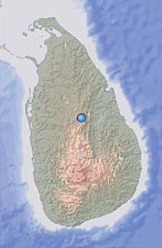 Sri Lanka lies just off the southeastern coast of India, a small island about the size of West Virginia (or a tad smaller than Austria or Scotland for European readers).
Sri Lanka lies just off the southeastern coast of India, a small island about the size of West Virginia (or a tad smaller than Austria or Scotland for European readers).It is known as “the Pearl of the Indian Ocean,” a tribute to the island’s natural beauty, people – even its shape.
Located in the Matale District of the Central Province (map), the column of rock is somewhat central to the country. Historians believe the region has been inhabited since the 3rd century BCE, making the site one of historical and archaeological significance to Sri Lanka.
The rock is known as Sīhāgiri, meaning “Lion Rock,” a nod to the giant animal carved from stone which greeted visitors at the entrance.
The site was a temporary capital from 477-495 CE when Sri Lanka was under the rule of King Kashyapa.
*
Kashyapa’s Reign
In 476 CE, King Dhatusena ruled over Sri Lanka. One of his illegitimate sons, Kashyapa, wanted the throne – but knew his full-blood brother Moggallana was next in line. Determined to stake his claim, Kashyapa schemed with the commander of the army to overthrow Dhatusena.
Lore says Kashyapa showed little mercy on his father, walling him up while still alive. But the message was clear, and it sent Moggallana fleeing to Southern India to escape a similar fate. With his dad and brother out of the picture, Kashyapa crowned himself king in 477 CE.
One of his first orders of business was to relocate the royal seat to Sigiriya from the traditional capital of Anuradhapura. It was ambitious and probably somewhat rooted in fear; King Kashyapa had killed the king and driven away the rightful heir to the throne.
In the interest of self-preservation, King Kashyapa immediately began work on his stone fortress.
*
The Lion Rock
King Kashyapa chose Sigiriya because he believed it would give his forces a strategic advantage if attacked. Its elevated position was an advantage to the defensive stronghold, offering fantastic 360-degree views. Plans to build a city quickly unfolded and after several years, the Sigiriya complex had become a bustling center for the new King.
The igneous rock earned its name from the enormous lion which greeted visitors halfway up the rock on a small plateau. A gateway to the Sigiriya, a lion carved from rock served to both welcome visitors and warn enemies.
(click to enlarge)
The lion paws are all that remain of the gate today
Sigiriya was both a palace and a fortress; the overall complex featured five gates and measured just under two miles wide (3 km) by just over a half-mile long (1 km). The site plan consisted of a citadel, an upper palace on the top of the rock, and lower palaces at ground level.
The King also constructed lavish gardens throughout, and for protection a moat with ramparts surrounded the complex.
The top of the rock was home to a beautiful landscaped gardens and the upper palace, today the oldest surviving palace in Sri Lanka. The upper gardens employed an advanced irrigation system which utilized surface and subsurface hydraulic systems.
Cisterns cut from the rock still function today.
*
The Culture
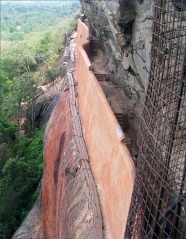 Frescoes adorn the western side of the rock, along with the mirror wall, a brick face covered in a highly-polished white plaster (pictured at left). When new, the wall was said to be able to produce reflections.
Frescoes adorn the western side of the rock, along with the mirror wall, a brick face covered in a highly-polished white plaster (pictured at left). When new, the wall was said to be able to produce reflections.Over time the Mirror Wall became a graffiti board, covered in verses scribbled by visitors. Known as “Sigiri Graffiti,” some of the messages date to the 8th century CE.
One inscription believed to be over 500 years old read:
“බුදල්මි. සියොවැ ආමි. සිගිරි බැලිමි. බැලු බැලු බොහො දනා ගී ලීලුයෙන් නොලීමි.”
Rough translation: “I am Budal. I came alone to see Sigiriya. Since all the others wrote poems, I did not!“
The message isn’t revelatory but if offers an insight to centuries-old human thought. Budal’s comment is not far off from what a visitor might offer today.
The tradition of additions by visitors forced officials to “close” the wall to new inscribing. To preserve the existing ancient graffiti, the wall is being treated to an on-going protective restoration.
A pocket in the Cobra Hood Cave is home to beautiful paintings of Sinhalese maidens performing various tasks. The maidens have escaped exposure to the elements for more than a millennium in the rock’s natural cavity.
The paintings are believed to be over 1,500 years old, and while the true significance is unknown, there are multiple theories. Some believe the maidens display religious rituals while others believe the images immortalize the many wives of the king.
The Maidens of Cobra Hood Cave at Sigiriya
*
The Gardens
One of the most breathtaking features of Sigiriya was the gardens, which consisted of three distinct components: The water gardens, the cave and boulder gardens, and the terraced gardens.
The water gardens occupied the western part of the Sigiriya complex and were further divided into three sub-sections. The first was a large plot surrounded by water connected to the main complex via four channels.
The second consisted of a path flanked by two long, narrow pools supplied water by nearby streams. Circular limestone fountains were fed by an underground aqueduct system. Built to last, the Sinhalese fountains still produce terrific displays today – especially during the rainy season.
The second garden also featured small ponds with four man-made islands on either side of the narrow pools. Two of the islets boasted ornate palaces which served as guest quarters for visiting dignitaries.
Just east of the second lies the third water garden, easily identifiable by the octagonal pool with a citadel on the northeastern corner.
Visitors to Sigiriya pass through the winding paths of the boulder gardens en route to the rock-top palace. Located just west of Sigiriya and geographically separating the rock from the western water gardens, the boulder gardens had decorative pavilions constructed on each rock.
As impressive as the water and boulder gardens were, the terraced gardens was arguably the most impressive. At the base of the Sigiriya the gentle natural incline was terraced and planted.
A limestone staircase divides the terraced gardens and guides visitors to a covered path which eventually leads to the main lion gate.
Symmetrical design was a staple of the gardens, which were connected to the outer moats on the west and the man-made lake (“Sigiriya Tank”) to the southeast. Additionally, an intricate underground conduit network interlinked the various pools and connected them to the lake.
Today the landscaped gardens of Sigiriya are the oldest surviving in Asia and among the oldest in the world.
*
The Rock Palace
The crown jewel of Sigiriya today is the king’s palace complex at the summit of the rock. Nearly a miniature city in its own right, it consists of a palace, fortified rock fortress, an organized system of cisterns, and various rock carvings and sculptures.
A massive rock wall protects Sigiriya from the east, although details are forthcoming as additional excavation of the eastern quarter is on-going and not yet complete.
*
Fall of The King
Moggallana, the rightful heir to King Dhatusena’s throne, would later defeat Kashyapa in 495 CE. Legend tells of the battle, in which Moggallana returns to Sri Lanka with forces to overthrow Kashyapa. During the battle, Kashyapa’s elephant balked at an obstruction and turned aside. The king’s troops mistook the movement as a retreat. The troops scattered and chaos ensued.
One version of Kashyapa’s demise is as flamboyant as the King himself: With no troops left for support and death imminent, Kashyapa drew his dagger, slashed his own throat, and sheathed the blade before collapsing dead.
After the battle King Moggallana moved the capital back to its historic seat in Anuradhapura.
*
After Kashyapa
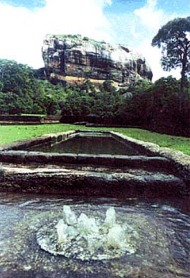 The gardens and palace at Sigiriya were abandoned, but later assumed by a Buddhist monastery which would occupy the land until the 14th century.
The gardens and palace at Sigiriya were abandoned, but later assumed by a Buddhist monastery which would occupy the land until the 14th century.There are no records of the activity at Sigiriya between the 14th and 16th centuries, but by the 17th century it was used as an outpost for the Kingdom of Kandy independent monarchy.
Western civilization re-discovered Sigiriya in 1831 when British army Major Jonathan Forbes of the 78th Highlanders discovered the bush-covered summit of Sigiriya on a horseback trip across the island.
In the 1890s archaeologist H.C.P. Bell spent some time at Sigiriya, overseeing a small dig and research operation.
[Jump to vintage Sigiriya picture gallery]
It would be another twenty years until the natural rock formation would return to the public eye; British explorer John Still’s visit to Sigiriya in 1907 sparked international discussion and renewed interest in the Sri Lanka treasure.
Full-scale archaeological work would not begin until 1982, when government-funded Cultural Triangle Project focused its attention on the ancient city. It was during this time historians learned of the Lion’s presence at the gate to Sigiriya, its head having collapsed long ago.
*
Legacy
The brief period as a seat of power and its remote location have conspired to push Sigiriya to history’s periphery, but the contributions by the ancient Sinhalese culture responsible make it no less significant.
Today the complex stands as one of the best-preserved examples of ancient urban planning. The gardens are the oldest surviving in Asia. Sigiriya is the most-visited historic site in Sri Lanka and is one of only 7 UNESCO World Heritage Sites in the country.
Sri Lanka proudly bills the ancient city as “the Eighth Wonder of the World,” and considering the advanced irrigation systems still bring water to the landscaped gardens over 1,500 years later, it has the résumé to be in the conversation.
*
Conclusion
Many of the details we have about Sigiriya are educated estimations based on results from archaeological digs, rough translations, known historic events, and sometimes simply lore. For example, we don’t know for certain whether Kashyapa began construction on Sigiriya or if he merely completed his father’s work.
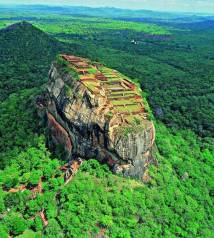 We don’t know whether Sigiriya was a fortified stronghold, a place of meditation and worship, or a pleasure palace for a playboy king. We do know Kashyapa overthrew Dhatusena, finished building and later occupied Sigiriya, and ultimately perished during battle at the site.
We don’t know whether Sigiriya was a fortified stronghold, a place of meditation and worship, or a pleasure palace for a playboy king. We do know Kashyapa overthrew Dhatusena, finished building and later occupied Sigiriya, and ultimately perished during battle at the site.King Kashyapa was a very small part of history in Sri Lanka, but the permanence of his rock palace is a testament to the brilliance of early Sinhalese engineering and design. While the Dark Ages plunged Europe into a dearth of culture, Sri Lanka was flourishing.
If there is a lesson we can learn from Kashyapa’s story, perhaps it is that no amount of fortification can defend against unlawful claims to the throne.
*
Activities, Pop Culture, & Tourism
• Visitors can reach Sigiriya by catching a bus in Dambulla, the closest city about 15.5 miles (25km) away. Bus service runs daily and every 30 minutes, between 6:30 a.m. and 6:00 p.m. Those with deeper pockets can enjoy tuk-tuk service from Dambulla, but at a price premium between 20-25 times higher than the bus fare.
• Visitors to Sigiriya will want to have good fitness. The citadel at the summit is an ascent of about 750 steps, most visitors are able to ascend and descend in about 2-3 hours. Be sure to bring bottled water as it is hot and beverages are not sold inside the park. Unofficial guides hover around the entrance and offer to give tours for a small fee.
• The museum at Sigiriya displays photographs of the excavation, reproductions of the frescoes, and translations of the Mirror Walls’ graffiti. Original artifacts and tools excavated from the site are also on display. The museum’s admission is included in the park’s ticket price; it is located just outside of the main gate. Admission is half-price for guests from India and Pakistan.
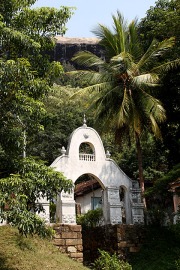 • Sigiriya is not the only attraction in the area; one click north of the complex is Pidurangala Rock, a popular alternative for rock climbers and those who prefer to avoid the crowds of the more popular Sigiriya to the South. Pidurangala is not quite as tall but provides spectacular views of its big brother and the surrounding area.
• Sigiriya is not the only attraction in the area; one click north of the complex is Pidurangala Rock, a popular alternative for rock climbers and those who prefer to avoid the crowds of the more popular Sigiriya to the South. Pidurangala is not quite as tall but provides spectacular views of its big brother and the surrounding area.The Pidurangala Sigiri Rajamaha Viharaya (pictured at right) is the modern white temple which serves as the entrance; if one continues up the rock, a terrace just below the summit is home to the Royal Cave Temple and a Buddha statue. For the novice visitors, unofficial guides well-versed in Sinhalese history will be happy to lead guests to the summit while giving a history lesson. For this they charge a small fee.
• Beware the wild elephants! They are known to roam the area – especially at night – and they are usually not very friendly. Fatal accidents involving elephants are not uncommon in the area.
• Duran Duran to use the plateau of the rock during filming of “Save a Prayer.” (Le Bon and Rhodes were reportedly dropped off from a helicopter for the shoot)
*
Views: 13
-
Comment by Besimi on October 3, 2014 at 9:32pm
-
A little more than 6 miles off the coast of Point Dume in Malibu, California, an unusual-looking structure sits on the sea bed floor. Based on images obtained on Google Earth, the oval-shaped object has a huge flat top and what appear to be pillars or columns that seem to reveal the entrance to a darker, inner place.
The anomaly -- for the moment, we'll call it that -- is approximately 2,000 feet below the surface of the water, measuring nearly 3 miles wide. What exactly is this thing?
According to the website of a California-based radio program, "Fade to Black," this may be "the Holy Grail of UFO/USO [unidentified submerged objects]" that researchers have been looking for over the last 40 years.
Watch this video created by "Fade to Black" radio host Jimmy Church about the Malibu underwater anomaly.
Jimmy Church, who hosts "Fade to Black" on the Dark Matter Radio Network, told The Huffington Post one of his listeners -- someone named Maxwell -- contacted him last month with a Google Earth image showing something odd, underwater off the coast of Malibu. Church then asked graphic designer Dale Romero to capture as many angled images of the anomaly as he could.
"I needed him to find a way to get it under and above the water," Church said. "My first impression was that it was Greek, it looked artificial and didn't look natural.
"When you're looking at it from above, it's a nearly perfect oval shape," Church continued. "In the natural surroundings, nothing is symmetrical. Everything is eroded and covered in rocks and sloping and peaking, and right here, for 2 miles, it is a perfect oval with a black separation or outline to it.
"It just stands out that it has to be some type of roof. It's not unlike a domed stadium or a covered indoor race track or an Olympic arena -- it's got that feel to it. It looks like a perfect oval manmade structure sitting on a construction site."
Using the Google Earth coordinates -- which are, by the way, 34° 1’23.31″N 118° 59’45.64″W -- Church and Romero came up with a series of images, starting from due south, looking north, all the way around and ending up at due north, looking back south.
Check out this Google Earth slideshow of the alleged Malibu Anomaly.
As unusual as this "anomaly" appears, is alien-UFO base the only realistic explanation for it?
"I didn't see anything special about it. I think it's because it looks like there's a flat surface and then, below it, it looks like there are these vertical columns, so somebody can say, 'Oh, this is the entryway to something special,'" said earthquake geologist David Schwartz of the U.S. Geological Survey.
"I think it's natural and is a part of the continental shelf," Schwartz told HuffPost. "It's just a complicated part of what's now offshore that has seen some erosion and, maybe, slumping when perhaps this was partially exposed when sea level was lower. This is a really major earthquake area and perhaps some of these features are a result of slope failures, due to shaking.
"There's no flag under the water that says: 'I'm the entrance to an alien base.' There's nothing unnatural-looking about it -- it's just showing some sort of variation in the offshore coastal morphology," Schwartz said.
Schwartz shared with HuffPost a research paper published in 2009by the Geological Society of America, showing cross-sections of the anomaly area -- designated as Sycamore Knoll -- by those who actually studied this underwater region.
The following image is from that paper. If you look to the left of the middle of the illustration, you can clearly see the oval-shaped "anomaly" some refer to as an underwater UFO base:
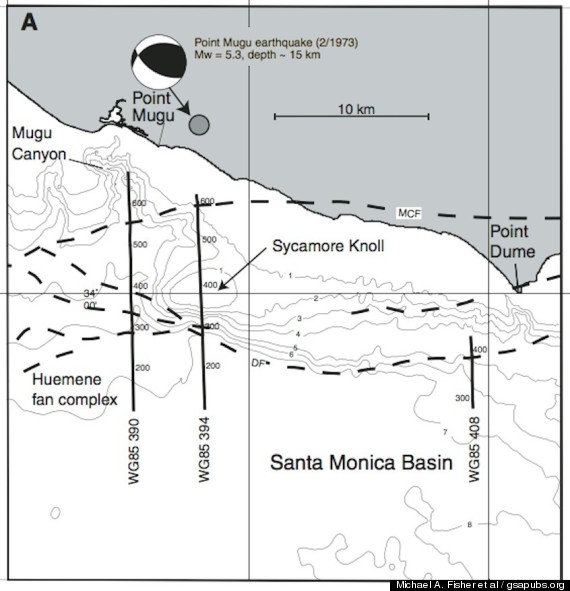
"This is interpreted as a thrust fault," Schwartz said, "meaning one side of the crust moves up over the other -- and what we're looking at is interpreted as being the surface expression of this Dume thrust, which is part of a large fault system in Southern California."
The bottom line, he added, "is that people have recognized this."
Could that be the final truth of what this object is?
HuffPost reached out to John Anthony West, an independent Egyptologist, who won an Emmy award for his research for the 1993 NBC documentary, "Mystery of the Sphinx," in which he and geologist Robert Schoch presented evidence that the Great Sphinx of Giza may be thousands of years older than previously thought.
West examined the images of the Malibu underwater object.
"The pictures are a bit misleading in that it looks as though it's on the shore," West told HuffPost. "My first reaction -- knowing that it was 2,000 feet under the water -- was that, under no circumstances could it, in fact, be artificial, manmade. And I have enough experience, looking at geology and distinguishing between what could perhaps be artificial, and then there's sort of a gray area in-between. As far as I'm concerned, there's no gray area."
West says he's inclined to go along with the geological explanation.
"It doesn't look at all manmade. It has what look like pillars there, but they're unevenly spaced and then, to the right, you see other seemingly pillars still attached, actually, to the bedrock, in the process of forming."
And yet, West acknowledges Unidentified Flying Objects.
"I'm convinced that UFOs are a reality -- there's too much evidence out there. Beyond that, we don't know anything. We don't know who they are, why they're here, [or] how much of this stuff is our own government. A point beyond that is that anything that isn't explained or that can't be explained by current scientific methods, automatically it's aliens. It's the explanation of last resort, and I just don't buy that."
Also weighing in on the Malibu mystery is former FBI Special Agent Ben Hansen, who has an extensive background investigating and analyzing questionable pictures and videos.
Hansen supplied HuffPost with the following Google Earth image of the underwater object in question:
"This was taken from a different angle of the 'mysterious base,'" Hansen told HuffPost in an email. "The dark areas that people are saying look like the inside of the base really starts to look just like shading of indentations to the shelf, and the 'pillars' are now represented as jagged ridges."
Hansen cautions about how we interpret things we see on Google Earth.
"Google obtains their underwater data from several different sources, including satellite radar and echo sonar from the Navy, NOAA, NASA and other agencies. Because they often use very different technologies, the derived information isn't always going to agree. When it doesn't, Google relies on its automatic 3D auto-generation programs to make sense of it.
"We're dealing with limited information to render the graphic because we can see it evidenced in the disparity of image quality between the anomaly and the areas immediately surrounding it," Hansen added. "The blurry sections and jagged edges obviously suggest a patchwork of image processing has taken place."
In the end, we're left with a variety of theories to explain the Malibu anomaly, a.k.a. Sycamore Knoll. Will the UFO-alien-underwater-base proponents be eventually proven right, leaving geologists in the deep blue dust, scratching their heads and wondering how theygot it wrong?
West concedes the possibility that this object could be an entrance of sorts, in the same way that the action of moving water can form caves below the surface.
"There's no big mystery to this thing 2,000 feet under the sea in terms of it being an entrance," West said. "Of course, until you get a camera there, you don't know where the entrance is leading. I'd hazard a guess that it doesn't go in too far, and if they do get in there, I think the chances are that they're not going to find the lost treasures of Atlantis
© 2025 Created by Besimi.
Powered by
![]()



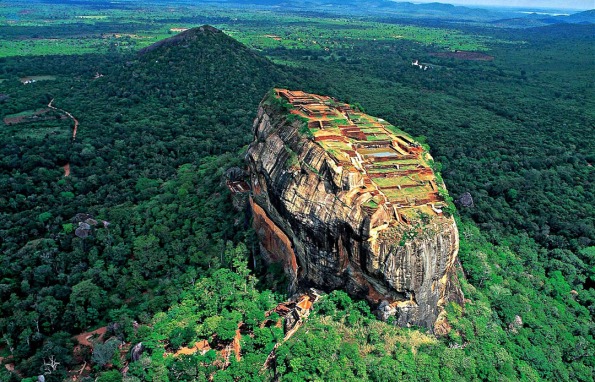

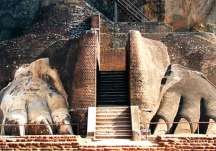
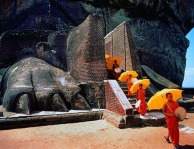

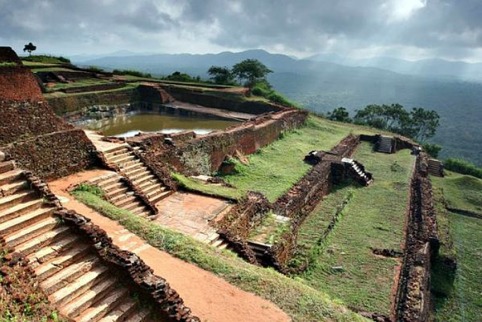
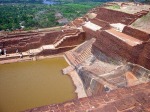
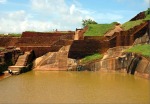
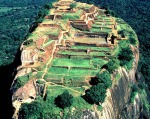
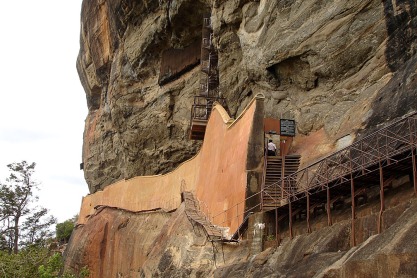
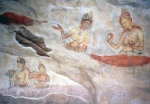
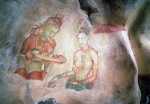
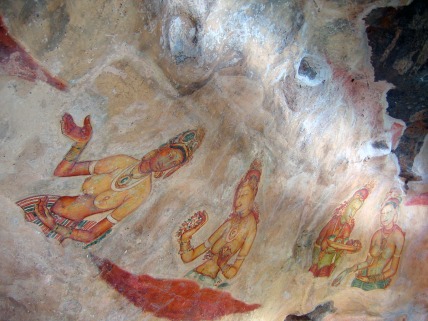
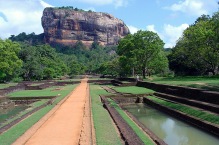
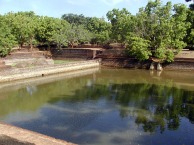


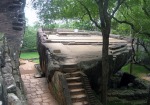

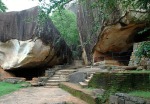
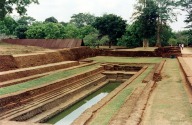
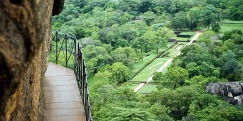
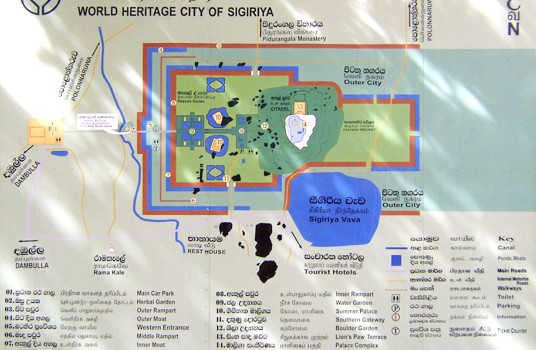

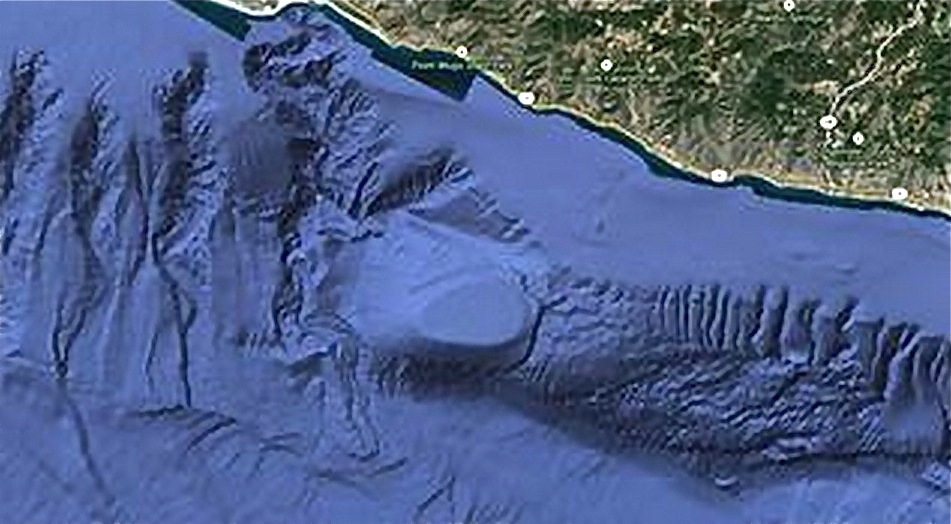









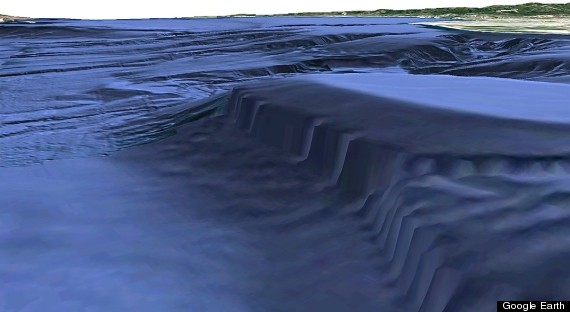

You need to be a member of Saviors Of Earth to add comments!
Join Saviors Of Earth